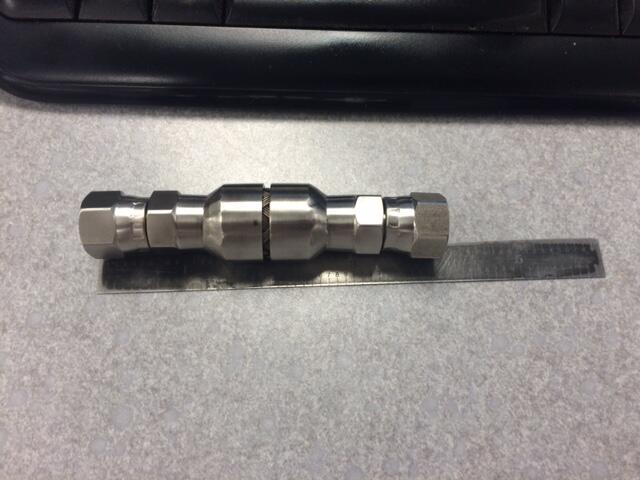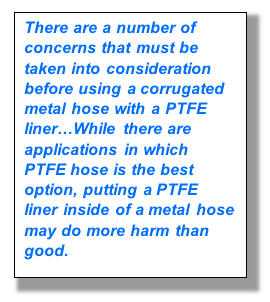Should You Install a PTFE Liner Inside a Corrugated Metal Hose?
By: Frank Caprio
Should you use a PTFE liner inside a corrugated metal hose?
We get various requests from our customers for non-traditional hose assembly constructions that they believe will help them solve tough application problems. Over the years, we’ve seen a lot of these, and some are pretty inventive, even if they’re not the best solution. Some other proposed solutions … not so good!
One especially challenging application that can drive people to consider specialized solutions is when the hose is exposed to corrosive media or environments. Typically, corrosion can be avoided simply by selecting an alloy that is resistant to chemical attack. However, certain refinery applications (such as those found in Cokers or FCCUs) entail operating conditions where some manufacturers recommend a special corrugated metal hose assembly which has been fitted with a liner made from smooth PTFE tubing. While this special construction sounds good in theory, it can create more problems than it solves. Let’s take a closer look at PTFE-lined corrugated hoses.
Why consider installing a PTFE liner inside a corrugated metal hose?
First of all, regular PTFE hoses offer advantages that cannot be denied; they are chemically resistant, they can be used for the transfer of food-grade materials, and they have excellent non-stick properties. However, there are certain applications where a PTFE hose doesn’t provide the durability that a metal hose can offer, so a compromise is made by inserting a smooth PTFE tube inside of a corrugated metal hose, and flaring the PTFE tubing out over the face of the end fitting (typically a pipe flange or some type of sanitary connection). The companies offering these assemblies make various statements regarding their operating capabilities. Some state that these liners can handle up to 30” of vacuum, can accommodate food-grade media, and help to prevent any escape of the media should the PTFE liner fail. The PTFE is also purported to have excellent resistance to large temperature fluctuations, although it has a limited temperature range as we will discuss below.
What to watch for:
There are a number of concerns that must be taken into consideration before using a corrugated metal hose with a PTFE liner.
- Pressure build-up outside of the PTFE sleeve. When a PTFE liner is installed, air is trapped between the I.D. of the corrugated hose and the outside of the liner. Gases trapped in this space can expand when heated, causing the liner to collapse, cutting off flow through the hose. To prevent this, a special port or weep hole must be installed behind the hose couplings to allow gases to vent out of (and into) the interstitial space between the O.D. of the liner and the I.D of the hose as those gases expand and contract due to temperature fluctuations.
- Temperature limitations. Standard PTFE tube materials have a maximum temperature rating of 350° F., and must be derated for operating temperatures exceeding 100 degrees F. Extreme temperatures could cause the PTFE lining to buckle, especially in vacuum service. Also, PTFE is not suitable for cryogenic applications.
- Pressure limitations. The PTFE lining typically cannot handle the full working pressure of the corrugated hose in which it is installed. Pressure spikes in these systems could lead to premature failure of the liner.
- Fire Safety. Obviously, PTFE’s temperature limits preclude it from being able to resist damage should an unexpected fire break out. Corrugated stainless steel hose assemblies with welded end fittings are able to resist flame tests, such as the NFPA testing required for flex connectors used in service stations to connect the Underground Storage Tanks (USTs) to the above-ground dispensing equipment. In addition to the above temperature limits, PTFE has a melting point of 623 degrees F., while corrugated metal hoses generally maintain their integrity at temperatures exceeding 1200 degrees.
- Dimensional variances. It is important that the PTFE liner fits snugly into the corrugated metal tube. This helps the PTFE liner resist “ovalizing” and eventual collapse under vacuum. Also, a snug-fitting liner reduces the susceptibility to damage from flow induced movements, by preventing the liner from flopping around inside the hose. Because many hose manufacturers have hose made both domestically and overseas on metric equipment, there can be significant variability of the actual I.D. of the hose, which can result in an improper fit between the hose and the liner. Several other precautions must be taken during assembly fabrication to minimize any potential damage to the liner.
- Flexibility issues. The PTFE lining is smooth bore, making it much less flexible than a corrugated metal hose. Our standard flexibility Annuflex products are more than twice as flexible when compared to the published Minimum Dynamic Bend Radii of 4” through 8” I.D. PTFE lined metal hoses.
- Permeation. Although PTFE is a very chemically resistant material, it will allow media to permeate through the wall of the liner, thus exposing the corrugated hose to the media being conveyed. This permeation minimizes any protection the PTFE liner may offer.
While there are applications in which PTFE hose is the best option, putting a PTFE liner inside of a metal hose may do more harm than good. This lining limits the pressure and temperature capabilities while potentially creating other problems that could be avoided entirely just by using a properly designed all-metal assembly made from corrosion-resistant alloys.
If you have any questions regarding the use of any non-metallic liner in a corrugated metal hose, talk to the metal hose experts at Hose Master. We’ve seen so many unique hose solutions (good and not-so-good), we can provide the safest, most cost-effective solutions for the toughest applications.

See the hose peeking out between the collars? Me neither.

Copyright 2018, Hose Master, LLC
All Rights Reserved
-
When to Use Flexible Metal Products
-
Select the Right Hose for Your Application
-
Select the Right Corrugated Metal Hose
-
Select the Right Stripwound Metal Hose
